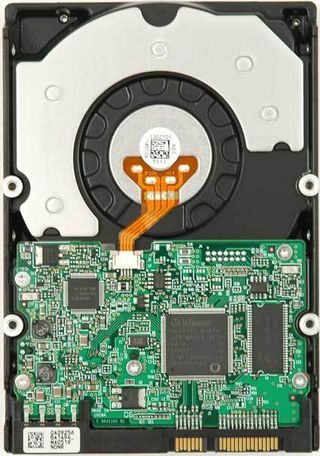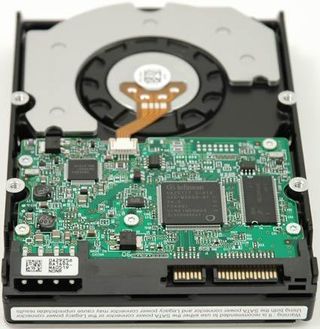Hitachi's 500 GB DeskStar Monster
DeskStar 7K500 Details
It's hard to distinguish among hard drives by looks alone, no matter who builds them. A close look at the label affixed to the drive enclosure is needed to establish what's what. Nor do typical modular designs for hard disks afford many options for drive capacity, either. It's only the choice of drive interface that gives vendors opportunities to create options for buyers: Among the Hitachi offerings, the HDS725050KLA360 is the SATA version, and the HDS725050KLAT80 sports an UltraATA/100 interface. The interface itself doesn't have much noticeable influence on data transfer rates, and the 7K500 for adequate performance for UltraATA/100 with a rate of 63 MB/s. But the 16 MB cache included with the SATA version bumps its read rates to 120 MB/s.
Cache is also a key factor: After Toshiba became the first vendor to offer 16 MB of drive cache for 2.5" notebook drives, Maxtor followed up with other high-value drives in this niche. For the first time, Hitachi takes the same path and equips its DeskStar 7K500 with a big onboard cache - but only with the SATA version! The UltraATA version remains at 8 MB, while the bigger cache for SATA makes sense in tandem with native command queing, which the DeskStar 7K500 also supports. In addition, Hitachi's DeskStar 7K500 also supports SATA-II data transfer rates of up to 3 Gb/s (2 Bit Parity) as well.
Overall, the 7K500 offered good results during our tests. As is typical for Hitachi, average access times fall within a pleasingly narrow range of values. But in data transfer benchmarks this monster drive takes a distant back seat to drives from other vendors, such as Samsung and Seagate.
I/O benchmarks put the 7K500 in the middle of the pack. When the SATA controller with NCQ support comes into play, it's clear that the drive could do better. But in the interests of objective comparison, we couldn't really dig into these capabilities. To that end, we're currently working on a new test environment that better guages these capabilities.
The heat dissipation of this drive is noteworthy, because its upper surface temperature of up to 127° F (54° C) is significantly warmer than competitor's offerings that incorporate only two or three drive platters. Active cooling for the DeskStar 7K500 is thus required.


Stay on the Cutting Edge
Join the experts who read Tom's Hardware for the inside track on enthusiast PC tech news — and have for over 25 years. We'll send breaking news and in-depth reviews of CPUs, GPUs, AI, maker hardware and more straight to your inbox.
Current page: DeskStar 7K500 Details
Prev Page Hitachi's 500 GB DeskStar Monster Next Page Test ConfigurationsMost Popular

